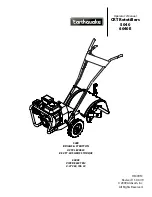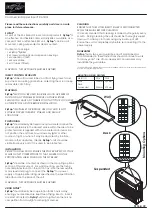
35
B.
Personal
Protection:
To reduce or eliminate contact with her-
bicides, it is necessary to wear adequate
protective clothing, respirators, boots, gog-
gles and gloves. The use of this equipment
is essential for good health especially when
applying some of the more toxic herbicides.
a.
Respirators - Protection against inhala-
tion (but no skin contact) is provided
quite economically by the use of face
mask respirators. Choose a mask that
will fi t your face and check with the
company about the details of fi lters and
chemical cartridges used in the respira-
tor model. Note that full and half face
masks cannot be worn securely by men
with beards, whiskers, sideburns and
moustaches. Instructions on the op-
erational life and performance of fi lters
and cartridges generally accompany
the products. However, when carry-
ing out spray operations, it is wise to
change the fi lters each day and the
cartridges should be replaced when
chemical odour is noticed. Wash the
face mask with warm water and soap
before installing a new cartridge and
fi lter. Do not store cartridge and fi lters
in the chemical storage area, as they can
absorb the chemical even when not in
use.
b.
Goggles - When a full mask is not worn,
the use of protective goggles is neces-
sary and is recommended to protect
the eyes from pesticide vapour, solids,
and accidental splashes particularly.
Safety supply companies off er a range of
goggles. Many goggles are resistant to
chemicals, some have specially treated
lenses to reduce fogging, others have
anti-fogging ventilation. Prescription
type glasses are also available to which
side shields can be attached.
c.
Gloves - Non-absorbent gloves should
be worn at all times when handling, mix-
ing and applying pesticides. Neoprene
has been found to be superior to rubber
in resisting the penetration of pesti-
cides. Other factors to be considered in
selecting suitable gloves include sense
of touch, wet grip, and cut and abra-
sion resistance. Gloves should not have
fabric wristbands or lining and should fi t
properly. Always wash the glove inside
and out after use. Leather gloves are not
suitable.
d.
Footwear - Non-absorbent footwear
should be worn when applying pes-
ticides. It is suggested that the most
suitable boot is one that is knee length,
acid and solvent resistant and ribbed to
prevent slippage. Neoprene is consid-
ered much superior to rubber. Leather
boots are not suitable.
e.
Clothing - For general protection
coveralls should be worn, along with
gloves and a hat to minimize the hazard
of the skin absorbing pesticides. Cloth-
ing should be changed and washed
regularly following spraying. You can
now purchase disposable clothing that
provides protection against exposure
resulting from pesticide drift, splashing
or spills. These garments (overalls, shirts
and pants, head cover, and aprons)
are light weight and cooler than rub-
ber articles. Protective equipment and
clothing are available from safety supply
companies. Never use leather garments
e.g. jackets, gloves, or shoes during the
handling or applications of pesticides.
Leather can absorb the chemical and it
is very diffi
cult to decontaminate leather
articles.
Summary of Contents for 973P Series
Page 1: ...1 HIGH CLEARANCE CENTER PIVOT SUSPENDED BOOM 3 PT FIELD SPRAYER 973P SERIES OPERATOR S MANUAL...
Page 45: ...45 Fig 62 BOOM TILT PIVOT 3 Grease boom tilt pivot 1 location each boom Left Right...
Page 59: ...59 7 4 ELECTRICAL SCHEMATIC OPTIONAL CABLE 10 CONSOLE 3 OR 6 BOOM SCS 440 450 CONSOLES...
Page 60: ...60 7 5 OPTIONAL CABLE FLOW CONTROLLER UP TO 6 BOOM VALVES...
Page 62: ...62 7 7 5 FUNCTION HYDRAULIC CAB BOX...
Page 63: ...63 7 8 5 FUNCTION HYDRAULIC CAB BOX SWITCH WIRING...
Page 67: ...67...















































